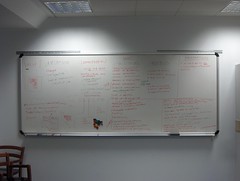Thesis brainstorming

Thesis brainstorming
Originally uploaded by dam.
Back to work on my thesis. Here are the notes from a brainstorming session with my advisor Neil Churcher, Vinay, and Nick. Now to explore visual and interface concepts.

Thesis brainstorming
Originally uploaded by dam.
Back to work on my thesis. Here are the notes from a brainstorming session with my advisor Neil Churcher, Vinay, and Nick. Now to explore visual and interface concepts.

Arduino London Worshop
Originally uploaded by dam.
I was in London this weekend to help Massimo, David, and Marcus teach another Arduino workshop. It was an early flight out on Saturday morning, two busy days of electronics and programming, and then a really early flight back to Milan on Monday morning. Not a bad way to spend the weekend, though it's always a bit difficult to watch people struggling with software you've written. Ah well, progress, though slow, continues.
An idea for a Lisp/Scheme editor in which code is always kept syntactically correct while allowing standard sequences of keystrokes to insert code.
So, all new typing appears in a raised text-box until a complete, valid identifier is entered, at which point its entire tree gets inserted with default values. For example, typing “(if” and pressing space would insert “(if #t #t #f)”, with the first “#t” highlighted. Then, for example, “(< ” would insert “(< 0 1)” with the 0 highlighted. Typing “x” and pressing space would yield:
(if (< x 1) #t #f)
with the 1 highlighted. Completing the conditional “(< x 1)” and pressing space would highlight the #t, etc. Completion lists would be offered at all times (except numbers or strings).
How does backspace work? It should be consistent with typing, so that mistakes can be corrected with backspace as in normal typing.